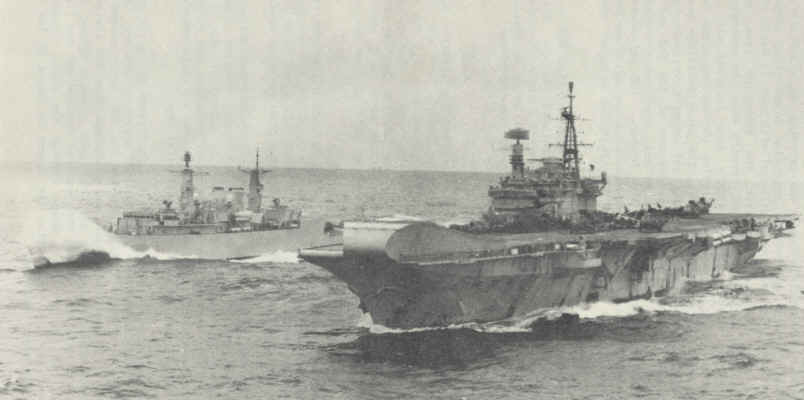
Goalkeeping on Hermes
T H E F A L K L A N
D S
At 0600 on 1st May a lone Vulcan bomber attacked the airfield at Port Stanley having been re-fueled in flight by Victor tankers from its base in Ascension - the round trip covering 6000 miles. One bomb hit the runway putting a large crater across it. At 1000 the ship went to Action Stations as HERMES launched 11 Harriers on bombing runs on Port Stanley and the airs trip at Goose Green. This strike produced three more small craters on the runway at Port Stanley as well as damaging many of the surrounding airfield buildings.
Throughout the day there were several calls to Action Stations for air raids but no enemy aircraft came near the main force except for two Canberra bombers looking for the carriers. However GLAMORGAN, ARROW and ALACRITY were bombed and strafed as they were bombing Port Stanley from close in shore.
These ships suffered minor damage but thankfully nobody was killed. The Harriers intercepted some of the attacking aircraft shooting down two Mirages, two Canberras and chasing many more back to Argentina. One of these fleeing aircraft was shot down by its own Argentine troops on the Falklands. The bombardment continued overnight and then the group in shore returned to the main force at the completion of a very successful day.
Initially Sunday 2nd May was very quiet but it livened up in the evening with the news that HMS CONQUEROR had torpedoed the Argentine cruiser, GENERAL BELGRANO. The action took place 35 miles outside the TEZ, which caused a few ruffles around the world, but the action was explained when MOD stated that the cruiser had been sunk because its six inch guns posed a threat to the Task Force. Waves of euphoria, tinged with sadness for the men now fighting for their survival in the icy seas, swept through the ship. Surely the actions of the past two days would bring the Argentine Junta to its senses and show them that we meant business?
Monday 3 May again saw a first for the Task Force. A Sea King on a surface search mission was fired on from two small surface vessels to the north east of Port Stanley. HMS Coventry's and HMS Glasgow's Lynx aircraft attacked the vessels with the newly acquired, but as yet unproven, Sea Skua air to surface missiles. One patrol boat sank and the other was severely damaged.
During all the action BROADSWORD had been performing her customary role as goalkeeper for HERMES. This involved the ship maneuvering upthreat, very close to the carrier to enable Sea Wolf to protect both ships from attack by missiles or aircraft. Our part in the conflict seemed to be along way from the action but the happenings of Tuesday 4 May brought the horrors of war that little bit closer. We had secured from our regular, dawn action stations and eaten lunch when suddenly we were called to action stations. There seemed to be a lot of confusion. At first it was announced that SHEFFIELD had suffered an internal explosion; it was then thought that she has been torpedoed; but it finally became clear that she had been struck by an Exocet missile fired from a Super Etendard fighter/bomber. It was unbelievable. "How could the aircraft have got close enough to deliver the missile". "Had any more Exocets been fired"? The answers are now history and weren't' then of any concern. What did matter was whether we could save the crew and the ship.

Goalkeeping on Hermes
The missile had ripped a hole in the ship's side and had started numerous fires. Her main problem was in containing the fires and when it was discovered that her fire main had been breached and all power lost, all the ships sent over portable fire pumps. It was to no avail - the flames got worse and after a four hour battle the ship was abandoned. HMS ARROW took off most of the survivors and the injured were rushed to HERMES for treatment. A sobering day for all. Argentina was beginning to even the score. To hammer the point home a Harrier was shot down over Goose Green and the pilot was killed.
During the following day the weather clamped and the ships remained in the eastern corner of the TEZ to think through the previous day's attack. Slowly the initiative was being lost but morale still remained high and people felt happier in the evening when it was announced that the SAS would be using their High Altitude/Low Opening technique to drop in over the Islands. Very little happened in the fog of the next few days except that unfortunately two Harriers collided in mid-air and both pilots were lost.